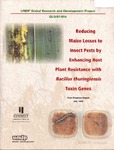| Abstract:
| Maize (Zea mays L.) is one of the principal crops in Mexico and other developing countries, where it is used for human and animal nutrition. Insects constitute a major threat to overall production levels of this vital cereal. The importance of insects as a yield-reducing factor increases dramatically when moving from temperate to tropical regions, where much of the developing world's maize is grown. It has been estimated that up to 15% of crops worldwide are lost solely to insect damage; in Mesoamerica, yield losses to insects exceed 30%. Among the various insect pests, Lepidopteran insects are among the most important in both the industrialized and developing worlds; infestations result in annual losses estimated at over 4 million tons in Brazil and 1 million tons in Mexico. Losses outside of Latin America are also dramatic. Despite the tremendous losses cause by these insects, many developing world farmers do little to control the pests, either because they believe that available measures are inadequate or because they cannot afford chemical insecticides. Current crop protection methods rely on the use of agrochemicals, which may be both costly for resource-poor farmers to procure and harmful to the environment. The primary bioinsecticide used to control insects is Bacillus thuringiensis (Bt) var. kurstaki, a bacterium that encodesproteins that are toxic to specific lepidopteran species. Bacillus thuringiensis is a species of soil-inhabiting bacteria that is found in most parts of the world. Under certain environmental conditions, the bacterium simultaneously forms a spore and a distinctive crystal, which are the principal sources of the proteins that produce Bt's toxic effects on particular insects. Because a single gene encodes each Bt toxin, it is relatively straightforward to genetically engineer a plant to produce the toxins. The isolation and modification of the gene (termed a "cry" gene) that genetically codes for these proteins allows their expression in plants. Among the many advantages to this control method, two were seen by this project's designers as especially important: (1) Bt proteins are highly specific to certain insect species and do not harm non-target insects; and (2) the World Health Organization has determined that these proteins are safe for humans, based on Bt's mode of action. Following is a synthesis of results from the UNDPsponsored project "Reducing Maize Losses to Insect Pests by Enhancing Host Plant Resistance with Bacillus thuringiensis Toxin Genes" (UNDP Project GL0/91/014). The US$ 5.4 million project, which ran from 1991 to 1998, was based at the International Wheat and Maize Improvement Center (CIMMYT) located just outside of Mexico City. The overall goals of the project were to use advanced genetic engineering technology from public and private sources to generate tropical maize germplasm that possessed enhanced and durable resistance to major insect pests of the crop (Southwest Corn Borer [SWCB], Sugarcane Borer [SCB), and Fall Armyworm [FAW)) and to provide the improved germplasm to breeders and farmers in developing countries. It was projected that by reducing maize losses to insect pests in tropical agricultural ecosystems, the transformed maize obtained from this project would eventually enhance maize productivity, food security, and reduce the need for pesticides in the developing world. The project also aimed to encourage legal and policy decisions by developing country governments to promote the growth of private sector involvement in agricultural biotechnology. By pursuing an integrated approach that combined applied research, product development, and policy development in the areas of biosafety and IPR, the project sought to assist developing countries with the technology in an environmentally and legally responsible manner. New technologies will certainly play an important role in enhancing the productivity of the agricultural sector, which will be a fundamental requirement for feeding the world's growing population. To gain access to many of these technologies, countries will need to have appropriate national and institutional policies in place to manage the innovations-this particularly applies to intellectual property rights (IPR). Technology transfer in the agricultural community is changing from informal, free exchange to formal legal agreements. The UNDP I CIMMYT project has taken an integrated approach to the multifaceted problem of technology transfer by combining applied research, product development, and policy development in the areas of biosafety and IPR to assist developing countries in not only accessing and generating technology, but also in using that technology in an environmentally and legally responsible manner. This project was hailed by external reviewers as one of the most successful biotechnology projects funded by UNDP. Under the auspices of the project, CIMMYI has succeeded in inserting Bt (cry) genes into tropical maize and in introgressing Bt genes provided by the private sector from temperate germplasm into maize cultivars with broad adaptation to the tropics and subtropics. The first wave of CIMMYT transgenic maize has already undergone field testing in Mexico; other materials developed under the project are currently being tested. The project has also facilitated collaboration between CIMMYI and the Government of Mexico in the development of biosafety regulations that govern field testing and the eventual release of transgenic materials. The achievements cited above confirm that CIMMYT has both the high level technical capability and the strong collaborative relationships with NARSs that are required to successfully execute global maize biotechnology research. The achievements also provide a strong foundation for the second phase of project activity, based on working closely with selected NARSs to move transgenic insect-resistant maize into farmers' fields. |

